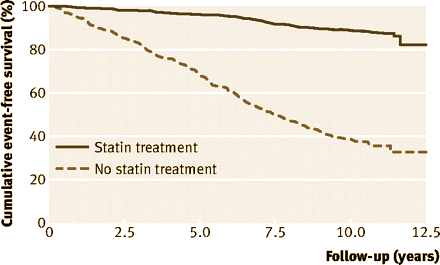When one is trying simply to be an informed patient and has become aware of all this corruption and COI in so many aspects of medicine, how on earth can a sound decision about medication be made? My internist wants me on statins; I have familial hypercholesterolemia and a family history of heart disease but I don’t smoke, I’m not overweight, I exercise, and I eat a fairly healthy diet. My blood pressure is okay. So how do I know whether or not I need to be taking a statin? This is all very confusing for those of us attempting to be good “consumers.” It’s tempting just to say I’ll take my chances and not take anything that’s advertised!
by Peter J Gill, MD/PhD student, Anthony Harnden, university lecturer in general practice, and Fredrik Karpe, professor of metabolic medicineBritish Medical Journal. 2012 344:e3228.
What is familial hypercholesterolaemia?
Familial hypercholesterolaemia is an inherited autosomal dominant genetic disorder characterised by high serum cholesterol concentrations detectable at a young age. It is associated with early cardiovascular disease, and an underlying genetic cause can be identified in about 80% of cases.
How common is familial hypercholesterolaemia?
Why is familial hypercholesterolaemia missed?
Underdiagnosis is a global challenge, with correct identification ranging from less than 1% in Russia to 20% in the Netherlands and 44% in Iceland. In the UK only 15% of patients with familial hypercholesterolaemia are expected to have been recognised in general practice. It is not known why patients with familial hypercholesterolaemia are often missed in primary care, but many seem to be diagnosed in middle age when family members present with coronary heart disease. Although patients diagnosed with familial hypercholesterolaemia are instructed to contact their relatives, several studies have shown that this is not effective in practice. The low referral rate to specialists for cascade DNA testing, the lack of national screening programmes, and the limited usefulness of clinical evaluation in relatives all probably contribute. Underdiagnosis is an even greater challenge among children and young adults, in whom clinical signs are rarely present.
Why does this matter?
Patients with familial hypercholesterolaemia have a high risk of mortality as they are exposed to high concentrations of plasma LDL cholesterol from birth. By early adulthood, without treatment they will have a 100-fold greater mortality risk from coronary disease than other young adults aged 20–39 years. Half of untreated heterozygous men and 30% of untreated women will have a myocardial infarction by the age of 50 and 60 years respectively. However, the development of effective cholesterol lowering drugs has reduced cardiovascular mortality, prolonging life by approximately nine years. A long term follow-up study showed that statins can delay atherosclerotic progression in children and young adults with familial hypercholesterolaemia. The risk of coronary heart disease is considerably higher in patients with homozygous familial hypercholesterolaemia.
by Jorie Versmissen, Daniëlla M Oosterveer, Mojgan Yazdanpanah, Joep C Defesche, Dick C G Basart, Anho H Liem, Jan Heeringa, Jacqueline C Witteman, Peter J Lansberg, John J P Kastelein, and Eric J G SijbrandsBritish Medical Journal. 2008 337:a2423.
Objective To determine the efficacy of statin treatment on risk of coronary heart disease in patients with familial hypercholesterolaemia.Design Cohort study with a mean follow-up of 8.5 years.Setting 27 outpatient lipid clinics.Subjects 2146 patients with familial hypercholesterolaemia without prevalent coronary heart disease before 1 January 1990.Main outcome measures Risk of coronary heart disease in treated and “untreated” [delay in starting statin treatment] patients compared with a Cox regression model in which statin use was a time dependent variable.Results In January 1990, 413 [21%] of the patients had started statin treatment, and during follow-up another 1294 patients [66%] started after a mean delay of 4.3 years. Most patients received simvastatin [n=1167, 33 mg daily] or atorvastatin [n=211, 49 mg daily]. We observed an overall risk reduction of 76% [hazard ratio 0.24 [95% confidence interval 0.18 to 0.30], P<0.001]. In fact, the risk of myocardial infarction in these statin treated patients was not significantly greater than that in an age-matched sample from the general population [hazard ration 1.44 [0.80 to 2.60], P=0.23].Conclusion Lower statin doses than those currently advised reduced the risk of coronary heart disease to a greater extent than anticipated in patients with familial hypercholesterolaemia. With statin treatment, such patients no longer have a risk of myocardial infarction significantly different from that of the general population.

1boringoldman hits it out of the ballpark AGAIN.
Here’s the deal (and it’s easily visualized): There is a central zone representing a relatively small population where the benefits of a drug outweigh risks at a fairly high degree of certainty. Radiating out from this central zone are bands of grayness, getting lighter and lighter, shading off into no benefit whatsoever.
The question is how far out in the gray zone does the recommendation for statins (or antidepressants, or proton pump inhibitors, or anticoagulants, or any chronic medication), push? Does it encompass populations who would see no benefit from the drug at a cost of side effects and wasted money?
Pharma and drug-oriented physicians want to cast the net as wide as possible, the former because it means more profits and the latter because they’d rather medicate prophylactically than trust their colleagues with diagnosis.